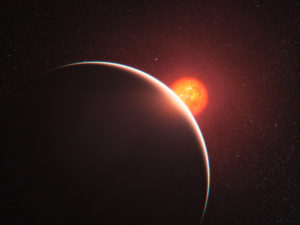close-in exoplanets
All posts tagged close-in exoplanets
Eve Lee and Eugene Chiang of Berkeley Astronomy just posted a very interesting paper about the origins of super-Earths in ultra-short-period orbits.
The topic I’ve been interested in most in recent years is the origin and fate of these ultra-short-period planets. These little guys orbit very close to their host stars, taking, in some cases, only a few hours to circle their host stars. In other words, the year for some of these planets is shorter than a feature-length movie.
Such planets were completely unexpected before astronomers began discovering them, and it’s not at all clear where they came from – naïvely, we’d expect that they can’t form where we find them. And many of them are so small (less massive than the Earth in some cases) that tidal interactions, which can cause bigger planets to death spiral into their stars, probably don’t have much effect.
In their paper, Lee and Chiang explored the origins of short-period super-Earths, planets somewhat, but not much, bigger than Earth. This population declines the closer you get to the host star – there are more super-Earths with periods of several days (short-periods) than of several hours (ultra-short-periods), which probably tells us something about the planets’ origins.
It was thought that such planets might originate via gas disk migration. This is the gravitational give-and-take between a nascent planet and the maternal gas disk from whence it arises.
Lee and Chiang found that, surprisingly, this migration on its own would not have made enough ultra-short-period planets but too many short-period planets. Next, they tried to include tidal interactions, which made enough ultra-short-period planets but too many short-period planets.
Instead, Lee and Chiang found that they could explain the short-period super-Earths if they assumed the planets formed near where we find them (and included a little tidal migration). That’s a little surprising since the standard model of planet formation posits that the grains of dust and ice that eventually coalesce to form planets cannot exist within a few days of their host star.
So, if Lee and Chiang are right, these super-Earths, instead of growing up from tiny grains, may have grown from the collisions of 1000-km planetesimals that themselves migrated close to the host star. In this case, the origins of short-period super-Earths may have been particularly violent.
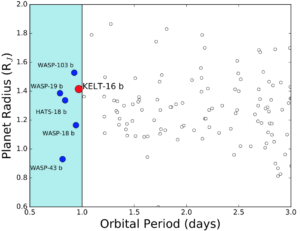
The radii Rp and periods P of KELT-16 b, along with lots of other short-period planets. From Oberst et al. (2017).
There’s a new paper from the KELT Survey and led by Prof. Thomas Oberst from Westminster College announcing the discovery of another exoplanet in a very small orbit, nearly skimming the surface of its host star: KELT-16 b is a highly irradiated, ultra-short period hot Jupiter nearing tidal disruption.
These planets have been something of a puzzle since the first was discovered back in 1995. Like Jupiter, they are mostly made out of hydrogen and helium gas, but unlike Jupiter, they orbit very close to their host star, which probably means they didn’t form where we see them today.
Even among hot Jupiters, though, KELT-16 b is an outlier. It’s one of a handful of hot Jupiters with orbital periods less than 1 day (as compared to Jupiter’s orbital period of 12 years), so whatever processes led to its origin are cranked up to 11 for KELT-16 b and its ultra-short period siblings.
The mystery of its origins aside, its short period means KELT-16 b is probably a good candidate for follow-up observations of its atmosphere, particularly by the James Webb Space Telescope. But tidal interactions with its host star means it may get eaten by its host star in less than a million years, so we need to get those observing proposals submitted soon.
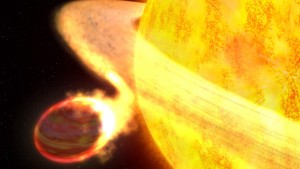
A hot Jupiter being ingested by its host star. From http://sen.com/thumbs/1024×576/img/47b3082d767346e8bebdb5ad99f8f33d.jpg.
Since astronomers have discovered hundreds of planets orbiting perilously close to their host stars over the last few decades, the question of what happens to planets when they wander too close to their host stars has intrigued astrophysicists.
These so-called close-in planets zip around their stars in just hours and are so close to their stars that the starlight heats their surfaces and atmospheres to thousands of degrees.
Since the planets’ atmospheres are so hot and puffy, the planets have only a tenuous gravitational hold on them, and some planets have been observed losing their atmospheres. I myself have made a hobby over the last few years of ripping apart exoplanets in the computer and of looking for their fossils in the sky.
How long it takes these hot Jupiters to lose their atmospheres and what’s leftover after the atmospheres are gone have been the subject of speculation for a while, and key to answering these questions is understanding what happens to the planets’ radii (and thus, their gravity) and what happens to the escaping mass.
A recent study by Shi Jia and Hendrik Spruit explores a new aspect of this Roche-lobe overflow process, and their results suggest the atmospheric disruption process might happen a lot faster than astronomers have thought.
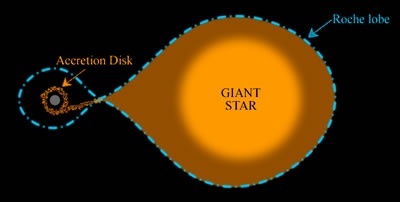
Accretion disk formation for a binary star system.
Previously, it had been assumed that, as a planet’s atmosphere is ripped away, it goes streaming down toward the host star, and the gas then goes into its own orbit close to the star, forming what’s called an accretion disk. This process has been studied for decades in binary star systems, in which one star donates mass to their other.
This accretion disk can then interact gravitationally with the disrupting planet, pushing it back away from the star a bit and moderating the rate at which mass escapes from the planet.
The upshot of this is that formation of the accretion disk can slow the disruption process, and so it could take billions of years for a Jupiter-mass planet to lose its entire atmosphere – a long time on human timescales but relatively short on astronomical timescales.
However, in their study, Jia and Spruit point out that these hot Jupiters undergo disruption very close to their host stars – so close, in fact, that, between the planet and the stellar surface, there might not be room enough for an accretion disk to form at all. Instead, gas that escapes the planet might just crash directly into the host star.
That’s a problem for the planet because if there’s no disk around, it can’t slow the mass loss rate, and so the planet might shed its entire atmosphere not in billions of years but just a few weeks – less time than it would take me to explain the process during a semester of astrophysics class.
Although the disruption process might be very fast, Jia and Spruit’s results suggest the remnants might be left around to be observed. What exactly they look like is still unclear, but the K2 and upcoming TESS missions will probably find lots of them (and may already have).
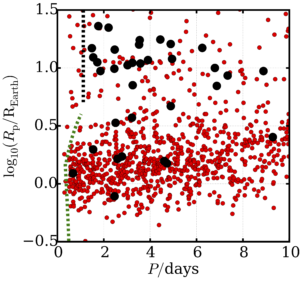
Planetary radii and orbital periods for planets (black circles) and planetary candidates (red circles) discovered by the Kepler mission. The dashed curves shows how close different planets can get to their host stars before they would be tidally disrupted. Taken from Jackson et al. (2016).
Exciting news – just today, my research group had another paper accepted for publication, so we’ve added one more tiny brick to the edifice of human knowledge.
This paper explored tidal disruption of gaseous exoplanets. Over the last few decades, astronomers have discovered thousands of planets outside of our solar system, so-called “exoplanets”.
Most of the planets do not resemble planets in our solar system, and owing to biases in the way we find the planets, many of them are big, gas balls like Jupiter but orbiting much closer to their host stars than planets in our solar system – these planets are called “hot Jupiters“. The figure at left shows how close some of these planets are to their host stars.
Many of these hot Jupiters are doomed to spiral in toward their host stars, and when they get too close, the star’s gravity can rip them apart in a process called “tidal disruption“.
In our recent paper, we studied that process to try to understand how close a planet can get before it’s ripped apart and what might happen as it’s being ripped apart. The upshot of our study is that planets might get ripped apart a little farther from their stars than is often assumed BUT that ripping-apart process might proceed fairly slowly, over billions of years.
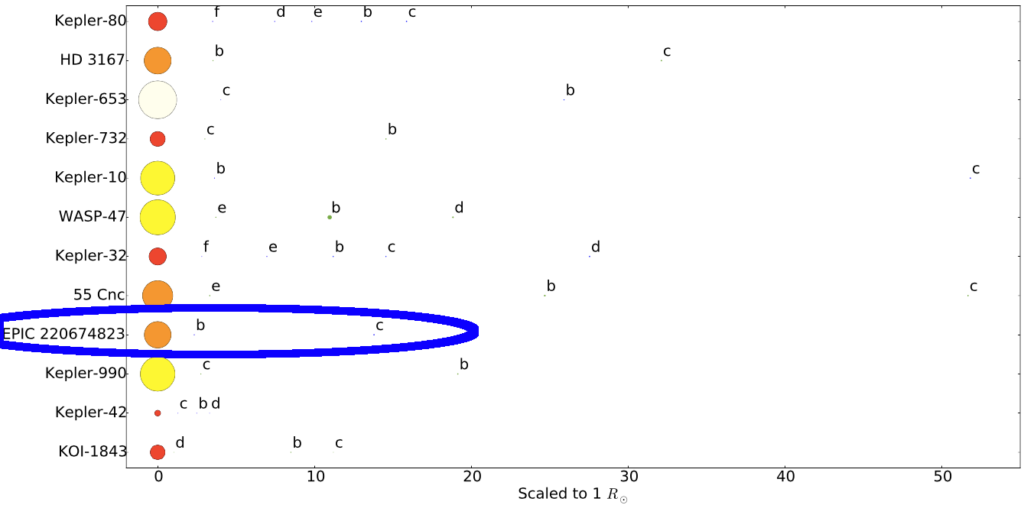
Twelve multi-planet systems where the innermost member is very close to the host star, that is, has an orbital period less than 1 day. From Adams et al. (2016).
Big research news today: our research group SuPerPiG, led by the inimitable Dr. Elisabeth Adams, announced the discovery of two new planets, EPIC 220674823 b and c.
Using data from the K2 Mission, we found these planets by looking for the shadows of the planets as they passed in front of their host stars, a planet-hunting technique known as the transit method.
These new planets are very different from planets in our solar system in several surprising ways.
First, they’re both bigger than Earth but smaller than Neptune – planet b is 50% larger, and planet c is 2.5 times larger. They inhabit a strange nether-region of planets where they’re known as super-Earths or sub-Neptunes, planets somewhere between Earth and Neptune. The reason there’s no specific name for such planets is because astronomers don’t understand this new class of planet at all.
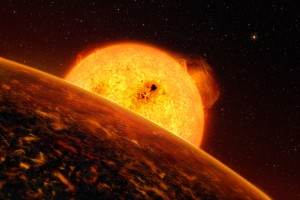
An artist’s conception of CoRoT-7 b, another ultra-short-period planet.
Second, both planets are MUCH closer to their Sun than the planets in our solar system. In fact, planet b is so close to its sun that it takes less time to orbit (14 hours) than all the playtime it took the Cubs to go from 3 games down to tying up the World Series. By comparison, planet c circles at the glacial pace of once every 13 days.
Another thing that’s interesting about our planets: they’re yet another system of with an ultra-short-period planet (USP) in which there is more than one planet, i.e. a multi-planet system. In fact, as we argue in our paper, most of the known systems with ultra-short-period planets are probably multi-planet systems and that fact might help explain the origin of these chthonic planets.

Beautiful Sky Pilot Mountain, south of Quest University.
The last two days of Exoclimes 2016 were as engaging as the first two — lots of great talks, discussion, and coffee break snacks.
The day 3 talks that really grabbed me were the first talks, focused on atmospheric mass loss from exoplanets since I’m currently working on that problem myself.
Ruth Murray-Clay gave a nice review talk about the variety of different mechanisms and regimes for atmospheric escape, while Eric Lopez suggested that, because escape should preferentially remove lighter elements from atmospheres, short-period exoplanets might retain water-rich envelopes, which could help us constrain their atmospheric compositions. Patricio Cubillos picked up on an idea previously explored by Owen and Wu and suggested that we could use mass-loss considerations to constrain the overall properties (density, etc.) of some short-period planets.
Other talks that stood out for me on day 3 included Eric Gaidos‘s talk about looking for geoengineering efforts by alien civilizations and Mateo Brogi‘s talk about measuring the spin rates of distant exoplanets, including GQ Lup b, a brown dwarf/high-mass exoplanet with a spin period of 3 days.
Day 4 of the conference whizzed by with a variety of talks regarding clouds and hazes in exoplanet atmospheres. Sarah Hörst taught us we should use the term ‘aerosol‘ instead of ‘clouds and/or hazes’ (since we’re not sure which of the two we’re seeing in exoplanet atmospheres).
Joanna Barstow and I rounded out the conference. She talked about her work analyzing exoplanet spectra and constraining aerosol (not clouds and/or haze) properties. Drawing upon the liturgical texts from the dawn of exoplanet science, I talked about my group’s work looking at Roche-lobe overflow of hot Jupiters (I’ve posted my talk below).
